Much is debated and demonstrated about the fighting applications within kata (patterns/forms), myself included. But not too much is spoken about the mindset, or mental approach you should take when performing your kata. Yes we all know that we should concentrate and focus, but beyond that . . . . what?
Whilst we are learning our kata, then obviously a certain amount of our concentration will be on making sure that we get the techniques and sequence correct. With practice we should be able to perform our kata without having to think about them very much. So now that we no longer have to think about the movements, what do we think about? What’s for dinner? Going for a drink afterwards? Or how cool we look doing this kata without thinking about it?
Well my answer might surprise some people, especially as a large part of our training is about self development and making ourselves better people. What I think you should do when you perform a kata that you know well is to pour all you nastiness, malevolence, viciousness and malice into your kata. That may sound strange from somebody who believes in self development as well as practicality, but please bear with me.
Real violence is nasty, malevolent, vicious and full of malice; and performing kata (or basics) is a mental rehearsal as well as a physical rehearsal. Thugs may not have good technique, but they are used to “training” in the “adrenalin zone”. When you have to fight to defend yourself or your loved ones, then you are entering the thugs world of real violence and you have to be able to cope with it. Adrenalin will effect your body, your perceptions and your ability to think. Your training should be real enough in your mind that you get a small adrenalin rush each time. Whilst too much adrenalin can be unhealthy, a regular amount at low levels is fine, plus you become more immune to it’s negative effects after a while. You will be able to remain calmer in a crisis.
Now some people may be concerned that training with this mindset may also train a thuggish mentality. But as soon as you finish your kata, you step up into Yamae (finish position), you go back to calm.
We train ourselves to “switch on” quickly and “switch off” just as quickly. If somebody attacks us, we do not want to freeze in shock (which happens even to high grade martial artists). That said, if we successfully defend ourselves and incapacitate our attacker, we do not want to jump up and down on their prostrate body or perform River-Dance on their head. We need to be able to stop and not be carried away in the heat of an unfamiliar moment.
As martial artists we need to know when to stop for legal and even more importantly; for moral reasons. We need to enter the world of vile malevolence when needed and exit it just as quickly when the job is done. However, nasty the thug may be, we as martial artists should be able to show mercy once we overpower him/her. It is part of the Yin & Yang of training and of our development. Its about balance in our personality.
The only way to have little or no fear of violence is to be good at it. I am not advocating that you act in a violent manner, but when you know that you can handle yourself in most situations, you project a confidence which most predators of the human world will recognise and they will be more likely to avoid you. Please note that I say “most situations”, as there will always be someone more experienced or better armed then you.
Most human predators mirror the animal predators. Think of the lion, king of the jungle. They hunt in prides, but do they for the big muscular young bull buffalo with the great big horns.
No.
They go for the old, the young, the weak, the one with the gammy leg that can’t run properly. Basically, for predators its about finding an easy target. For us training is about making you a hard target, physically and emotionally. The big fit bull with the horns does not need to threaten the lions, the lions just know. So it is when you walk with an air of confidence, the human predators just know.
But projecting true confidence is not just about how you walk or your posture. It’s about knowing that you are prepared physically and mentally should a conflict make it necessary. As Bruce Lee once said in his films, “the art of fighting without fighting”.
I heard of a study years ago where they got 3 groups and tested them at throwing balls through a basketball hoop. After recording the results, they had one of the groups practice shooting the balls at the hoop, one of the groups not practice at all; and the third group just visualise throwing balls at the hoop. Later they tested the three groups again. The group that practiced improved by something like 24% (if I remember right). The group that did not practice made no improvement at all.
The amazing thing though was that the group that just visualised throwing the balls improved dramatically, with about a 23% improvement. Visualisation achieved almost as good a result as doing the real thing. Therefore whilst practicing kata, using visualisations of the violence and malevolence of the situation can actually help you prepare for it more than most people give it credit for (even if you don’t fully understand the bunkai). Although good technique is important, unless you are practicing primarily for competition it should not always be your main focus. Funikoshi said that spirit is more important than technique and he primarily taught by kata rather than kumite (sparring).
This concept may be a bit new to some people. Whether it’s new to you or not, please leave a comment below to tell me what you think, I’d like to hear from you.
By Charlie Wildish, 3rd Shotokan Karate & Lotus Nei Gong Tai Chi


 To be honest, my first thought was “what can I say about focus mitts“. After all a focus mitt is a focus mitt, they are not complicated pieces of equipment and as long as they can withstand the impact then they do their job!
To be honest, my first thought was “what can I say about focus mitts“. After all a focus mitt is a focus mitt, they are not complicated pieces of equipment and as long as they can withstand the impact then they do their job!


